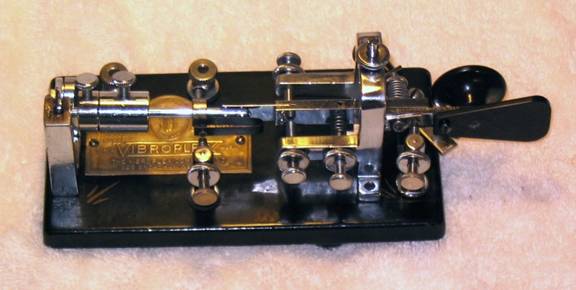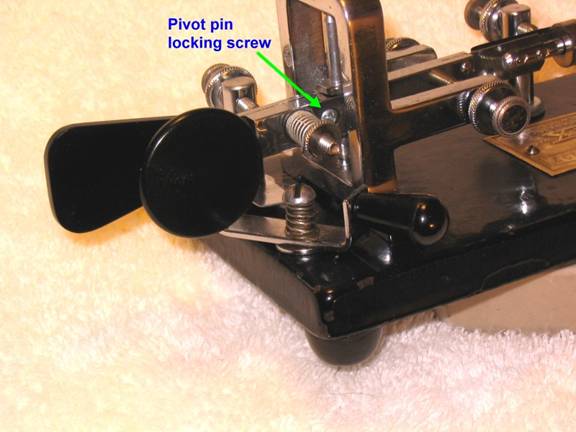On Identifying and Dating Vibroplex "Bugs"
- A Peculiar Instance Worth Noting -
K4MSG - Paul Bock of Hamilton, Virginia
Reported and photographed by Paul Bock - K4MSG
November 14, 2007
Click here for other articles by Paul posted to the LARG Internet Site
Elsewhere on the LARG Internet Site, (Click Here), I have provided descriptive information to assist the interested collector or owner of Vibroplex semi-automatic keys in identifying the various models and determining their authenticity. Characteristics such as style of the hardware, paint finishes and color, type of plating, serial number, etc., are all useful as aids in recognizing what a particular model is and when it was likely manufactured.
But sometimes we get fooled. This is particularly true when buying "sight unseen" or strictly from photographs, and from non-collectors who may not really know what they have and do not provide adequate detailed descriptive information - usually a "sin of omission" with no real deception intended. Such was the case on a recent "bug" purchase made using eBay.
The item in question was ostensibly a Vibroplex Junior, a less-common model that was actually manufactured between the early 1920s and 1939 but only actively advertised from 1934 onward. It was a "standard" Vibroplex Original but with the parts mounted on a slightly smaller base (6" x 3" instead of the usual 6.25" x 3.5"). It was available with the common black-japanned base with gold pinstripes or an optional nickel-plated base, with all of the top parts nickel-plated. Other than the base size the only distinguishing feature of the Junior is that the brass nameplate was mounted facing the right side of the bug instead of the left, the latter being common for the Original, No. 4 or Blue Racer, No. 6 or Lightning Bug, etc.
Enter the bug in question. It was listed on eBay as a Vibroplex Junior with a serial number of 85xxx which dated it to about 1922. It was a little dirty in the photographs but, yes, the base was 6" x 3" and it had a black japanned finish with a vestige of gold pin-striping remaining. The speed weights were missing and it had an oval-shaped thumb piece of the type used exclusively on the WWII Lionel J-36 (a Vibroplex Lightning Bug clone) but otherwise it looked authentic, with one exception: The nameplate faced left instead of right!

Knowing the history of the Junior and the fact that it wasn't called that until 1934, I surmised that perhaps the very early Juniors did have the nameplate mounted the "standard" way and only later was the orientation changed to distinguish a Junior from an Original (which, without a ruler handy, might have been difficult to do). There are stranger variants in the way that Vibroplex sometimes did things than changing a nameplate's orientation after some models have already been built & sold. The "Buy It Now" price being reasonable (less than $100) I purchased the bug.

After it arrived and I examined it I could see that the nameplate did in fact face the left a la an Original, but the base was 6" x 3" and it did not appear that the nameplate had ever been removed and re-oriented. But when I took a close look it was apparent that the parts were not nickel-plated but chrome-plated, something that didn't occur until 1940, several years after the japanned base coating had been dropped in favor of black wrinkle paint.
In addition, the lever arm had the tell-tale pivot pin locking screw that wasn't introduced until around 1944, after the company had begun to manufacture the jewel-bearing Deluxe models with a non-adjustable top jewel inserted from underneath the top of the frame.

Prior to this innovation on the Deluxe models the pivot pins were press-fitted into the lever arm and couldn't move, but since the top & bottom trunion screws were both adjustable this permitted accurate vertical alignment of the dot contacts. However, having a non-adjustable top jewel meant that maintaining vertical alignment of the dot contacts from instrument to instrument would require precise setting of the pivot pin in every lever arm. Manufacturing tolerances being what they were, Vibroplex opted for making the pin a loose fit in the lever arm and adding a locking screw, thereby permitting the lever arm to be raised and lowered by sliding it up and down on the pin to vertically align the dot contacts. Since lever arms were made interchangeable except for the pins themselves (Deluxe pins were rounded on top & bottom while "standard" pins were conical points) this pin locking screw appears on all bugs built from about 1944 until the company move to Portland, ME, around 1979.
Well, "caveat emptor" as the saying goes. I disassembled, cleaned, checked, and reassembled the bug. I did notice that the nameplate was installed with tiny screws instead of the rivets normally used but the area under the nameplate was extremely shiny compared to the rest of the base, and since the nameplate is asymmetrical - meaning that a change in position would be obvious from the condition of the finish underneath - it was apparent that the nameplate had never been re-oriented. There was a vestige of the gold pin-striping remaining on the base and the nameplate matched the design for a 1922 D1-style Vibroplex nameplate (even down to the typo on one of the listed patent numbers) so both were declared authentic.
After reassembly I added speed weights, installed a reproduction triangular thumb piece, and tested the bug. I must confess that it is one of the sweeter sending Vibroplexes I've ever used, It is certainly a keeper since I am a bug user and not really a collector any longer, and it fills a current need for an "extra" bug for one of my three rig set-ups.
So, how did a 1922 japanned Junior base with a 1922 nameplate on it end up with a collection of post-WWII chrome-plated parts? I can only surmise that possibly one of the following things happened:
|
(a) The original nickel parts became so worn and unattractive that someone who wanted a smaller-base bug decided to swap them for the parts on a late '40s Original; (b) Someone restoring another older bug needed authentic nickel-plated Original parts and took them off, leaving just a base that was later "rebuilt" using newer parts; (c) Someone using this bug professionally sent it back to Vibroplex to be rebuilt in the 1940s or early 1950s. |
I suspect that either (a) or (b) is probably the correct answer. I should note that the drilled studs normally used for the binding posts are missing and have been replaced with 8-32 nuts, and the knurling on the binding-post thumbnuts is of late 1940s or early/mid 1950s type which is different from that used in the 1960s. The binding post studs can be bought from Vibroplex so that's an easy replacement for chrome-plated parts. Were the rest of the parts nickel-plated I'd have to manufacture my own studs on the lathe and brush nickel-plate them to keep the parts with the same plating.
But whatever the true history, I now have a very functional - if not accurate in terms of construction details - Junior-sized Vibroplex, the base & nameplate of which are about 85 years old.
Of course, I **COULD** look for an old Vibroplex Original from the 1920s or 1930s and thereby procure a set of nickel-plated parts to restore "Junior" to his original configuration - but would he send as nicely? Probably best to leave well-enough alone!
Paul Bock, K4MSG